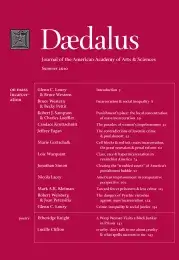Crime, inequality & social justice
Crime and punishment are certainly contentious topics, and the authors gathered in this issue do not always agree with one another. For my own part, I must confess to having a personal stake in this issue. As an African American male, a baby boomer born and raised on Chicago’s South Side, I can identify with the plight of the urban poor because I have lived among them. I am tied to them by the bonds of social and psychic affiliation. I myself have passed through the courtroom and the jailhouse on my way along life’s journey. I have twice been robbed at gunpoint. I have known–personally and intimately–men and women who lived their entire lives with one foot on either side of the law. Whenever I step to a lectern to speak about incarceration, I envision voiceless and despairing people –both offenders and victims–who would have me speak on their behalf. Of course, personal biography has no authority to compel agreement about public policy. Still, I prefer candor in such matters to a false pretense of clinical detachment and scientific objectivity. While I recognize that these revelations will discredit me in some quarters, that is a fate which I can live with. Allow me to share a few critical observations of my own about crime, inequality, and social justice.
One principal point of disagreement among contributors to this volume has to do with how the fact of mass incarceration relates to the social problem of crime. Mark Kleiman claims that mass incarceration is only a partial problem definition; the other part of the problem is crime. This stance is in sharp contrast to that of Loïc Wacquant, who insists that “hyperincarceration” (his preferred term, since only those living in the lower social strata face much risk of imprisonment) isn’t really about crime at all. Rather, he says, it’s about “managing dispossessed and dishonored populations.” There is merit in both viewpoints. There can be no doubt that public ideas about crime–especially fears of violent victimization–have fueled the imprisonment boom. To speak of a crisis of mass imprisonment without reference to crime is, indeed, to address only one part of the problem. After all, declarations of “war” against crime (and, most noticeably, against criminals) are a primary means by which political aspirants now signal their bona fides to their electorates. The long upward trend in crime rates from the mid-1960s to the early 1980s “primed the penal pump” by hardening attitudes and discrediting liberal criminal justice . . .
